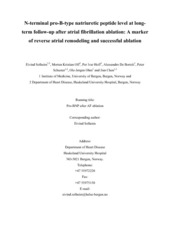N-terminal pro-B-type natriuretic peptide level at longterm follow-up after atrial fibrillation ablation: A marker of reverse atrial remodeling and successful ablation
Solheim, Eivind; Off, Morten Kristian; Hoff, Per Ivar; De Bortoli, Alessandro; Schuster, Peter; Ohm, Ole-Jørgen; Chen, Jian
Peer reviewed, Journal article
Accepted version
Permanent lenke
https://hdl.handle.net/1956/5364Utgivelsesdato
2011-10-13Metadata
Vis full innførselSamlinger
Originalversjon
https://doi.org/10.1007/s10840-011-9629-2Sammendrag
Aims: We investigated the relationship between arrhythmia burden, left atrial volume (LAV) and N-terminal pro-B-type natriuretic peptide (NT-pro-BNP) at baseline and after long-term follow-up of atrial fibrillation (AF) ablation. Methods: We studied 38 patients (23 paroxysmal, six women, mean age 56±11) scheduled for AF ablation. LAV was calculated on the basis of computed tomography images at baseline and long-term follow-up, and arrhythmia burden was graded from self-reported frequency and duration of AF episodes. Results: After a mean period of 22±5 months, 28/38 patients (11/15 persistent) were free from AF recurrence. At baseline there were no differences in mean LAV (125 vs. 130 cm3, p=0.7) or median NT-pro-BNP (33.5 vs. 29.5 pmol/L, p=0.9) between patients whose ablation had been successful or otherwise. At long-term follow-up there was a marked decrease in LAV (105 vs. 134 cm3, p<0.05) and level of NT-pro-BNP (7 vs. 17.5 pmol/L, p<0.05) in the successful ablation patients. NT-pro-BNP correlated with LAV both at baseline (r=0.71, p<0.001) and at follow-up (r=0.57, p<0.001). Arrhythmia burden correlated with both NTpro- BNP (r=0.47, p<0.01) and LAV (r=0.52, p<0.01). A decrease in NT-pro-BNP at followup of > 25% of baseline value had a specificity of 0.89 and a sensitivity of 0.6 (receiver operator characteristics, accuracy 0.82) for ablation success. Conclusions: NT-pro-BNP correlates with LAV and arrhythmia burden in AF patients and both NT-pro-BNP and LAV decrease significantly after successful ablation. A decrease in NT-pro-BNP of >25% from the baseline value could be useful as a marker of ablation success.
